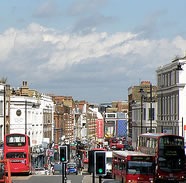Council say figures show policy of reducing number of polluting buses is working
 Figures released by Wandsworth Council
Figures released by Wandsworth Council
Provisional data from both of pmonitoring stations on Putney High Street suggests a major fall in pollution episodes. Wandsworth Council is claiming that this is due to sustained investment in the heavily polluting bus fleet taking effect.

Between February and June this year the EU’s hourly nitrogen dioxide (NO2) objective was exceeded 6 times at the kerbside pollution monitor, compared to 742 times during the same six month period in 2016 and 640 times in 2015.
The council’s other high street monitoring station, which is mounted to a building façade further from the traffic, recorded zero hourly pollution episodes since the start of February. This compares to 200 last year and 135 in 2015.
Back in 2012 there were 1,213 pollution episodes during this six month period – so this year’s provisional figure would represent a 99 per cent fall.
Councillors stress that the data is provisional at this stage and that there is still more work to be done before residents are breathing consistently clean and healthy air. There were pollution episodes in January so the street has already breached the annual legal limit, which is set at 18.
The levels of fine particles (PM10) on the high street have remained within EU limits since testing began in 2009.
The fall in pollution coincides with the introduction of cleaner buses along the street which have been put into service since the council’s unique 2012 research project exposed the bus fleet as responsible for over 80 per cent of nitrogen dioxide build ups. Mayor Sadiq Khan announced in March this year, that Putney would be the first Low Emission Bus Zone in a bid to “tackle toxic air”.
At peak times more than 100 buses per hour use this relatively narrow road, causing diesel fumes to quickly build up.
The council has also made improvements to Putney High Street’s layout and traffic signals to ease queuing, and a ban on delivery vehicles stopping to unload has been introduced to reduce congestion further.
Deputy council leader Jonathan Cook said, “These provisional results are encouraging but our goal is to meet the EU pollution limit and we’re not there yet. It looks like our campaign to ban polluting buses from Putney High Street has had a major impact and our ban on daytime deliveries could also be a significant factor is cutting the congestion which contributes to pollution build ups.
“However we can’t accept older polluting buses simply being switched to other routes and we want assurances from the Mayor that he has stopped this divisive policy. Trading one community’s health for another’s is wrong and we want to be sure that polluting buses are being taken off our streets altogether.”
Wandsworth Council argues that removing diesel buses from London’s streets should be the top priority for the Mayor of London’s air quality strategy.
The council is now pushing for the removal of high emission buses from other pollution hotspots within the borough, including Clapham Junction and Tooting where buses represent a high proportion of the traffic flow.
August 10, 2017